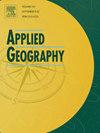Towards an infrastructure approach: The interactive relationship between spatial distribution of hospitals and urbanization in Chinese major cities
IF 4
2区 地球科学
Q1 GEOGRAPHY
引用次数: 0
Abstract
The uneven distribution of healthcare resources has emerged as a prominent concern in healthy city development globally. However, extant research mainly follows an amenity approach that merely regards hospitals as passive spatial carriers of healthcare services and rarely considers them as an integral part of the urbanization processes, overlooking the interactive relation between hospitals and urbanization and their implications for the supply-side healthcare inequalities. This study introduces a hospital-city nexus framework highlighting hospitals as crucial infrastructure for urban development, and incorporates open big data and statistical data to examine the interactive relationship between hospital clustering and urban structures across 36 major Chinese cities. The study identifies prevalent hospital clustering in China, characterized by specific morphology, land use, and institutional composition. Higher hospital clustering occurs in cities with low financial capacity, low per capita income, and advanced medical technologies. Land use and locational attributes are key factors in hospital clustering, while transport services play a lesser role. Hospital clustering is positively associated with nearby housing values, but the relationship with population density and aging are diverse. Highlighting the hospital-city nexus, this study enhances the supply-side understanding of the uneven spatial distribution of hospitals, informing relevant healthcare policy and urban planning.
走向基础设施:中国主要城市医院空间分布与城市化的互动关系
卫生资源分布不均已成为全球健康城市发展的突出问题。然而,现有的研究主要遵循舒适化的方法,仅仅将医院视为医疗服务的被动空间载体,很少将其视为城市化进程的一个组成部分,忽视了医院与城市化之间的互动关系及其对供给侧医疗不平等的影响。本研究引入了医院-城市关系框架,强调医院是城市发展的关键基础设施,并结合开放的大数据和统计数据,研究了中国36个主要城市医院集群与城市结构之间的互动关系。该研究确定了中国普遍存在的医院集群,其特点是特定的形态、土地利用和机构组成。医院集聚度高的城市财力较弱、人均收入较低、医疗技术较先进。土地利用和区位属性是影响医院集聚的关键因素,交通服务的影响较小。医院集聚与附近住宅价值呈正相关,但与人口密度和老龄化的关系则不同。本研究强调医院与城市之间的关系,增强了对医院空间分布不均匀的供给侧理解,为相关的医疗政策和城市规划提供信息。
本文章由计算机程序翻译,如有差异,请以英文原文为准。
求助全文
约1分钟内获得全文
求助全文
来源期刊

Applied Geography
GEOGRAPHY-
CiteScore
8.00
自引率
2.00%
发文量
134
期刊介绍:
Applied Geography is a journal devoted to the publication of research which utilizes geographic approaches (human, physical, nature-society and GIScience) to resolve human problems that have a spatial dimension. These problems may be related to the assessment, management and allocation of the world physical and/or human resources. The underlying rationale of the journal is that only through a clear understanding of the relevant societal, physical, and coupled natural-humans systems can we resolve such problems. Papers are invited on any theme involving the application of geographical theory and methodology in the resolution of human problems.
 求助内容:
求助内容: 应助结果提醒方式:
应助结果提醒方式:


